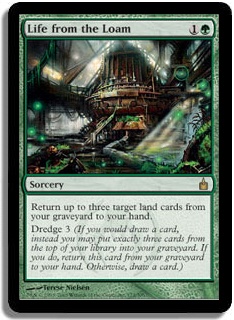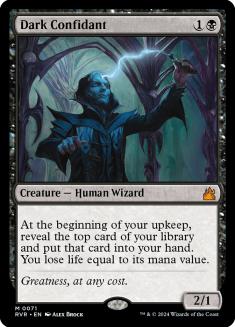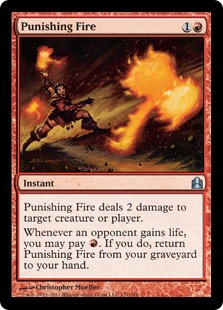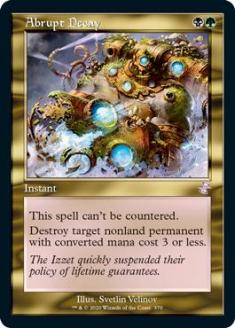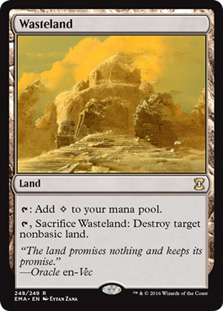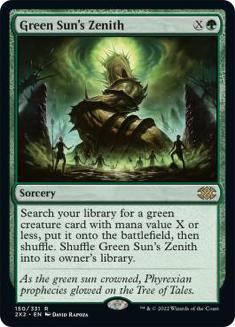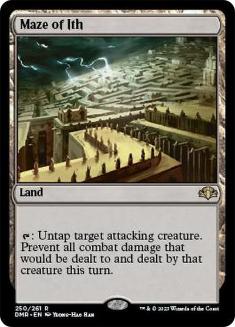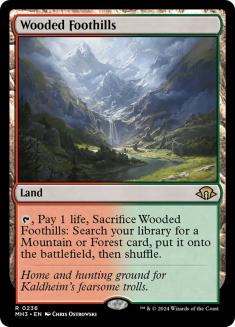I’ve had many people ask me if I would be willing to write a primer for the Four-Color Loam deck I’ve now played to three Top 4 finishes at SCG Legacy Opens this year—so this is for them. I’ve been playing various incarnations of Four-Color Loam since I was first handed the deck to play a side event with at Grand Prix Indianapolis in December of last year.
The first time I resolved a game-winning Devastating Dreams, I knew I was hooked on this archetype. This article is intended to be a primer for the deck, so if you are more interested in reading event reports, you can find my summary from SCG Open Series: Indianapolis here and SCG Open Series: Atlanta here.
Before I begin talking about the deck, I would like to provide a 75 to reference:
Creatures (8)
Lands (26)
Spells (26)

This is the exact 75 I played at both the SCG Legacy Open in Atlanta and the SCG Legacy Open in Milwaukee—I have been very happy with the cards it contains.
Card Selection
This deck is powerful, fun, and flexible because it is able to attack from a number of different angles. As implied by the deck’s name, this list is powered by a Life from the Loam engine. Life from the Loam is a powerful card because it is what we like to refer to as “self-enabling” since it allows you to “draw” three lands from your graveyard and it’s also kind enough to fill up your graveyard with said lands.
The lands Life from the Loam recur for us perform a number of tasks. Wasteland allows us to attack greedy opposing mana bases, Nantuko Monastery attacks opposing planeswalkers/players, and when just lands aren’t enough, cycle lands (Forgotten Cave and Tranquil Thicket) allow us to draw into spells. When we have an active Loam, there are few (if any) other decks in the Legacy format that can match our card advantage. Because of this, we play seven Life from the Loam in our deck.
Well, clearly we don’t play seven physical copies of Life from the Loam in our deck (that would be cheating). What I mean by “seven” copies of Life from the Loam is that we play seven virtual copies of Loam in our deck. We achieve this by playing three copies of Life from the Loam in our maindeck and leaving the fourth copy in our sideboard as a Burning Wish target (this also helps us play around getting all our Loams Surgical Extractioned in games 2 and 3).
Thanks to our carefully sculpted sideboard, Burning Wish often resembles a Demonic Tutor in the Loam deck. Need to kill a troublesome creature or planeswalker? Grab a Dreadbore. Your opponent has too many annoying artifacts or enchantments out? Shattering Spree or Reverent Silence should put them in their place. Chainer’s Edict can kill both Emrakul, the Aeons Torn and Nimble Mongoose, and Perish is one heck of a blowout against Elves and Maverick.
Another card in the sideboard that I mentioned above is Devastating Dreams. The quickest route to victory with this Life from the Loam shell is resolving a Knight of the Reliquary and then following it up with a Devastating Dreams large enough to destroy all of our opponent’s lands. Because Dreams destroys lands in addition to dealing damage to creatures, it is near impossible to kill our own Knight with one. This allows Devastating Dreams to often be a Wrath of God and Armageddon that leaves us with a massive Knight of the Reliquary on our side of the table.
The last bit of card selection I’d like to talk about are the two artifacts that I play full sets of: Chalice of the Void and Mox Diamond. The number we most often want to put Chalice on is one. If you look over the decklist, you will note that I have taken care to only include three cards in the 75 that have a CMC of one. Many other Legacy decks, on the other hand, often include twelve or more one mana spells—meaning a Chalice of the Void on one often increases your opponent’s dead draws by twenty percent or more!
Mox Diamond synergizes well with how we’ve built our deck to interact with Chalice on one. Just because most all of our spells cost two mana doesn’t mean we want to wait until our second turn to start casting things! Dark Confidant, Sylvan Library, and Chalice of the Void all make for fantastic first turn plays.
Mulliganning
Because of how flexible this Life from the Loam deck is, the outcome of the games we play relies heavily on every choice we make while playing. These choices start as soon as we draw our opening hand—proper mulliganning is critical for playing Loam properly. This is one of the many decks in Legacy where simply doing a “lands and spells” check before keeping is a terrible idea.
Let us consider the following sample hand:
The above seven definitely passes the lands and spells check. What you should be seeing, though, is that aside from the Green Sun’s Zenith we can’t actually cast any of the spells in this hand. Is a Dryad Arbor (fetched with the Zenith) on turn 1 followed up by a Wasteland going to be enough to win the game? Almost every time it isn’t—this hand has to go back.
If we take the above seven and change just a single card though:
It becomes an entirely different ball game. Wooded Foothills gives us access to the two colors the previous sample hand was missing (red and black). Depending on what we are playing against, this hand has several different series of plays. First consider:
Turn 1: Play Wooded Foothills -> fetch Bayou, cast Green Sun’s Zenith -> find Dryad Arbor.
Turn 2: Play Wasteland, cast Dark Confidant using Bayou + Dryad Arbor, Wasteland their nonbasic land.
[Editor’s Note: Jeff even plays around Daze in his theoretical games. I love it!]
This series of plays is fairly aggressive, but if they are unable to answer our early Dark Confidant (while we simultaneously attack their mana), the odds of us drawing into the red mana we still need is high (and we are now drawing two cards a turn).
If we want to be more conservative with our line of play (or expect our Dark Confidant to be removed right away), we can always save that Wooded Foothills to grab a Badlands so we have access to all four of our colors. This allows us to spend our second and third turns answering our opponent’s plays with Punishing Fire and Abrupt Decay. Then on our turn 4 we can use Green Sun’s Zenith to find a Knight of the Reliquary.
I could easily fill an entire book with ideas about what hands to keep and the different lines of play various hands offer us. Today, however, I would just like to touch on one last thing that is a common question: how to sideboard. The following is how I generally sideboard with my above 75 against some of the more popular archetypes in the current Legacy metagame.
Sideboarding
RUG/BUG Delver
Out: -1 Green Sun’s Zenith, -1 Gaddock Teeg, -2 Burning Wish
In: +1 Abrupt Decay, +1 Bojuka Bog, +1 Dreadbore, +1 Maelstrom Pulse
Jund
Out: -1 Green Sun’s Zenith, -1 Gaddock Teeg
In: +1 Abrupt Decay, +1 Bojuka Bog
U/W/R Miracles
Out: -3 Punishing Fire, -1 Life from the Loam, -1 Knight of the Reliquary
In: +1 Abrupt Decay, +1 Gaddock Teeg, +3 Thalia, Guardian of Thraben
Esper Stoneblade
Out: -1 Gaddock Teeg
In: +1 Abrupt Decay
Elves
Out: -1 Knight of the Reliquary, -1 Life from the Loam
In: +1 Abrupt Decay, +1 Gaddock Teeg
Goblins
Out: -4 Chalice of the Void
In: +1 Abrupt Decay, +1 Thoughtseize, +1 Maelstrom Pulse, +1 Dreadbore
Sneak and Show (and Generic Combo)
Out: -3 Abrupt Decay, -1 Punishing Fire
In: +3 Thalia, Guardian of Thraben, +1 Gaddock Teeg
Wrap Up
I’ve been having a blast playing Four-Color Loam for the last five months. During that time, I’ve played in eight competitive REL events, and my combined record across all of them is 47-16-8 (with every draw being intentional). That is roughly a 75 percent win percentage—something that is not bad at all for high level events. If you have any questions/comments about the deck, feel free to post them as a comment below.
Cheers,

